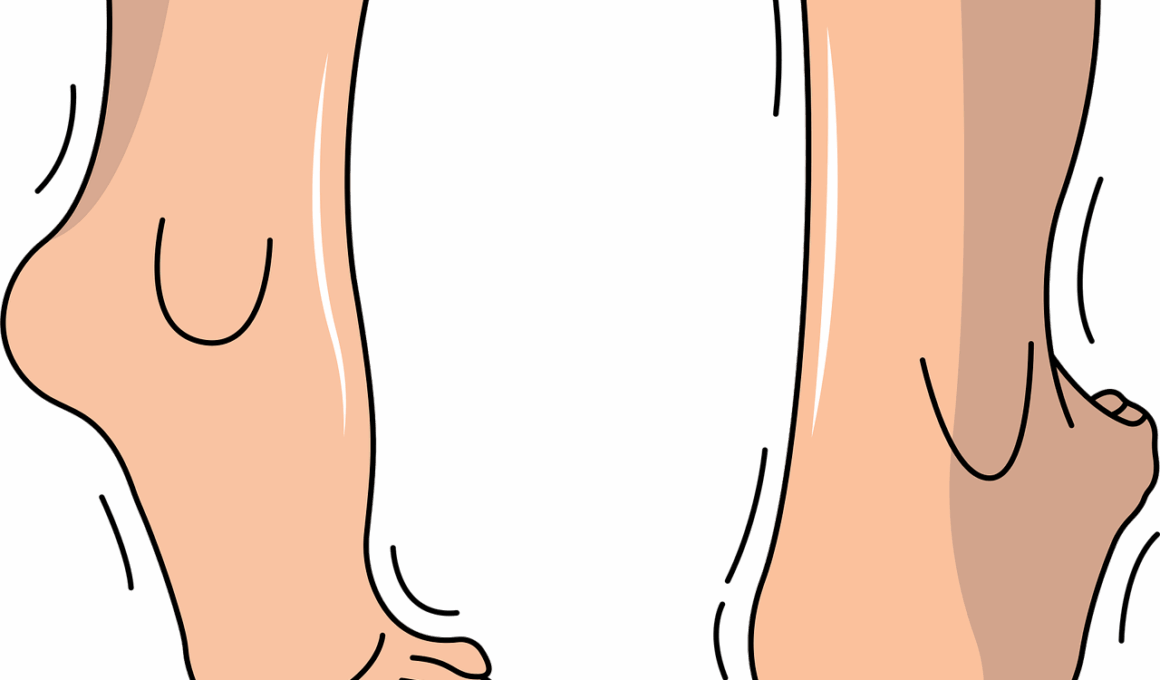Epidemiology of Ankle Injuries in Various Sports Disciplines
Ankle injuries are among the most frequently encountered injuries in sports, significantly affecting athletes across various disciplines. Understanding the epidemiology of these injuries is crucial for implementing effective prevention strategies. Compounding factors, including the sport’s specific requirements and the athlete’s physical condition, determine the prevalence of ankle injuries. In sports like basketball and soccer, rapid changes in direction increase the risk substantially. The mechanism of injury often includes an inversion or eversion of the ankle, leading to sprains and fractures. Data indicates that male athletes exhibit a higher incidence of ankle injuries compared to females, possibly due to differences in activity levels and physicality. Furthermore, previous injury history is a significant predictor for subsequent injuries. Age is another influencing factor with younger athletes generally suffering more ankle injuries. The need for targeted training programs to improve flexibility and strength, along with effective footwear, is paramount to reduce injury rates. Longitudinal studies provide insights into ankle injury patterns, helping coaches and medical staff tailor injury prevention strategies based on specific sport demands.
The prevalence of ankle injuries varies significantly across sports disciplines, highlighting the need for sport-specific research. For instance, basketball players encounter higher rates of ankle injuries due to frequent jumping, landing, and pivoting, which places considerable stress on the ankle joints. Track and field athletes also report injuries, particularly with hurdles and sprints that involve rapid ankle motion. In contrast, sports like swimming and cycling have minimal ankle injury reports, as they have lower impact and stress on the joints. Furthermore, a study revealed that the types of ankle injuries differed among sports, with sprains and strains being more common in high-impact sports. It is critical to analyze the cultural and environmental factors contributing to these injuries, such as the type of playing surface and weather conditions. Education on correct techniques and injury recognition among athletes can further aid in managing risks effectively. Researchers emphasize the need for injury surveillance systems to document incidents comprehensively. Such systems ensure valuable data for understanding trends, risk factors, and inform prevention strategies tailored to specific sports disciplines.
Risk Factors for Ankle Injuries
Diverse risk factors contribute to the prevalence of ankle injuries in sports, including intrinsic and extrinsic elements. Intrinsic factors encompass individual characteristics such as anatomy, previous injuries, and flexibility, while extrinsic factors relate to environmental components like playing surfaces and equipment. A heightened understanding of these risk factors is essential for athletes, coaches, and medical professionals. For instance, athletes with a history of ankle sprains are statistically more likely to sustain future injuries, making previous injuries an important consideration in injury prevention efforts. Furthermore, poor balance, weak musculature, and inadequate flexibility compound the likelihood of sustaining an injury. According to recent research, surfaces such as grass provide better shock absorption compared to hard surfaces like concrete, which are more conducive to injuries. Another significant risk factor is the lack of proper footwear tailored to the specific sport. Coaches should implement strength training routines that emphasize ankle stability and proprioception to mitigate risks associated with injuries. Through comprehensive education and training, athletes can be better equipped to prevent ankle injuries and ensure longevity in their sports careers.
Prevention Strategies for Ankle Injuries
Implementing effective prevention strategies is vital in reducing the rates of ankle injuries in sports. Different approaches can be adopted based on the nature of the sports discipline. First and foremost, educating athletes about the risks and signs of ankle injuries plays a critical role in prevention. Training programs aimed at enhancing proprioception, strength, and flexibility are crucial to strengthen the ankle and prevent injuries from occurring. Specific drills and exercises focusing on balance and stability can prepare athletes better for the demands of their sports. Furthermore, proper warm-up routines before physical activity help in reducing injury risks. Wearing appropriate, well-fitting footwear tailored to the activity can also diminish injury incidence significantly. Athletes should be encouraged to use ankle braces or tape in high-risk situations, which can provide additional support during gameplay. It’s essential to monitor athlete workloads carefully, allowing adequate recovery time to prevent fatigue-related injuries. Collaboration between coaches, trainers, and medical professionals is crucial to developing individualized training plans that prioritize injury prevention while optimizing performance and training routines.
Research on ankle injuries patterns within different sports disciplines is paramount for future advancements in prevention and treatment protocols. Notably, systematic reviews and meta-analyses provide insights into common trends and associated risks among athletes involved in distinct activities. These studies highlight variance in injury severity, recovery times, and recurrence rates, which can significantly impact an athlete’s career. For example, studies show that basketball players often recover more slowly due to the complex nature of their ankle injuries during abrupt movements. Comparatively, soccer players tend to sustain more sprains but generally have shorter recovery periods. Understanding these variations informs both medical staff and coaching strategies to address rehabilitation effectively. Early identification of injuries influences prognosis and recovery trajectories, promoting timely interventions. Collaborative research efforts among sports medicine specialists are needed to deepen the understanding of how different sports impact injury epidemiology. As the sporting landscape evolves, sports health professionals must remain vigilant, adapting injury prevention techniques based on new burgeoning data on injury occurrences across various disciplines.
Conclusion and Future Directions
In conclusion, the epidemiology of ankle injuries in various sports disciplines indicates a clear need for comprehensive prevention strategies. Each sport presents its unique challenges requiring tailored approaches to mitigate the risks involved. The importance of injury data collection cannot be understated, as it serves as a foundation for developing future interventions aimed at reducing ankle injuries. While current strategies have provided valuable insight, advancements in technology and research methodologies offer exciting opportunities for enhanced understanding. Future directions in sports medicine could explore the role of biomechanics in ankle injury occurrences, providing deeper insights on injury mechanisms. Additionally, studying gender differences in injury prevalence and recovery can foster personalized treatment plans that consider individual athlete needs. Collaborations between researchers, practitioners, and coaches will be essential to drive innovation in training routines and rehabilitation protocols. Ultimately, fostering a culture of safety and awareness among athletes will not only enhance performance but also extend careers. Continued investment in research is crucial to driving our understanding of ankle injuries, leading to effective prevention methods and improved athlete health.
The impact of ankle injuries goes beyond the immediate physical consequences, influencing athletes’ psychological wellbeing and performance levels. Acknowledging the importance of psychosocial factors is critical in the rehabilitation process. Athletes must deal with fears of re-injury and the emotional repercussions of being sidelined. Mental conditioning programs targeting anxiety associated with upcoming competitions after an injury can be beneficial. Furthermore, immediate access to rehabilitation services after an injury can mitigate long-term psychological effects. Understanding the athlete’s mindset is essential in crafting effective recovery strategies. Physicians and trainers must prioritize communication while supporting athletes throughout their recovery journey. An interdisciplinary approach involving psychology alongside physical rehabilitation can provide holistic healing, aiding faster and healthier recovery outcomes. Researchers should investigate the links between mental resilience and the ability to bounce back from injuries to develop comprehensive support structures. Finally, addressing the psychological hurdles associated with ankle injuries is crucial to ensure athletes can perform at their peak level post-injury. By separating emotional responses from physical rehabilitation, sports medicine can evolve to incorporate a more comprehensive approach to injuries.
In summary, the epidemiology of ankle injuries in various sports disciplines reveals that understanding these injuries is critical for preventing their occurrence. Sports medicine continues to evolve, and so does the knowledge surrounding intervention strategies and rehabilitation practices. By recognizing the factors contributing to ankle injuries and implementing preventive measures, athletes can pursue their sports with minimized risk. As new technologies and research advancements emerge, opportunities to improve treatments and preventive protocols will increase. Future studies must focus on expanding knowledge in this domain to further reduce the incidence of injuries and promote athlete welfare and longevity in sports. The collaboration between sports scientists, medical professionals, and athletes themselves is crucial in driving forward an evidence-based approach to sports injuries. Lessons learned from historical data can inform better practices and contribute to a culture of safety within sports communities. Longitudinal studies examining the long-term impacts of injuries on athletes will also play a vital role in shaping future strategies. Overall, a comprehensive understanding of ankle injury epidemiology is essential in fostering healthier athletic environments, ensuring athletes remain safe while enjoying their chosen sports.


